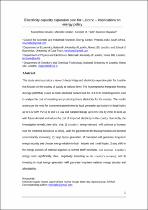JavaScript is disabled for your browser. Some features of this site may not work without it.
- ResearchSpace
- →
- Research Publications/Outputs
- →
- Journal Articles
- →
- View Item
| dc.contributor.author |
Senatla, Mamahloko

|
|
| dc.contributor.author |
Nchake, M

|
|
| dc.contributor.author |
Taele, BM

|
|
| dc.contributor.author |
Hapazari, I

|
|
| dc.date.accessioned | 2018-10-19T06:04:17Z | |
| dc.date.available | 2018-10-19T06:04:17Z | |
| dc.date.issued | 2018-09 | |
| dc.identifier.citation | Senatla, M., Nchake, M., Taele, B.M. and Hapazari, I. 2018. Electricity capacity expansion plan for Lesotho – implications on energy policy. Energy Policy, vol 120, pp 622-634 | en_US |
| dc.identifier.issn | 0301-4215 | |
| dc.identifier.issn | 1873-6777 | |
| dc.identifier.uri | https://www.sciencedirect.com/science/article/pii/S0301421518303951 | |
| dc.identifier.uri | http://hdl.handle.net/10204/10476 | |
| dc.identifier.uri | https://doi.org/10.1016/j.enpol.2018.06.003 | |
| dc.description | Copyright: 2018 Elsevier. Due to copyright restrictions, the attached PDF file only contains the preprint version of the published item. For access to the published version, please consult the publisher's website. The definitive version of the work is published in Energy Policy, vol 120, pp 622-634 (https://doi.org/10.1016/j.enpol.2018.06.003) | en_US |
| dc.description.abstract | This study aims to produce a research-based integrated electricity expansion plan for Lesotho that focuses on the security of supply at national level. The Autoregressive Integrated Moving Average (ARIMA) is used to model electrical demand and the PLEXOS modelling tool is used to analyse the cost of investing and producing future electricity for the country. The results underscore the need for investment geared towards local generation particularly in large hydro up to 0.22 GW, PV up to and 1.1 GW and pumped storage up to 0.5 GW by 2050, to keep up with future demand and reduce the cost of imported electricity in the country. Succinctly, the investigation reveals, inter-alia, that: 1) Lesotho's energy demand will continue to increase over the modelled period (up to 2050), with the gap between the local generation and demand concomitantly increasing; 2) large hydro generation, if harnessed will guarantee long-term energy security and cheaper energy relative to both imports and small hydro; 3) any shift in the energy policies of external suppliers at current tariff structures, will increase Lesotho's energy costs significantly, thus, negatively impacting on the country's economy; and 4) investing in local energy generation will guarantee long-term national energy security and affordability. | en_US |
| dc.description.uri | https://doi.org/10.1016/j.enpol.2018.06.003 | |
| dc.language.iso | en | en_US |
| dc.publisher | Elsevier | en_US |
| dc.relation.ispartofseries | Workflow;21123 | |
| dc.subject | Electricity supply | en_US |
| dc.subject | Import | en_US |
| dc.subject | Supply deficit | en_US |
| dc.subject | Electricity expansion plan | en_US |
| dc.subject | ARIMA | en_US |
| dc.subject | Reserve margin | en_US |
| dc.title | Electricity capacity expansion plan for Lesotho – implications on energy policy | en_US |
| dc.type | Article | en_US |
| dc.identifier.apacitation | Senatla, M., Nchake, M., Taele, B., & Hapazari, I. (2018). Electricity capacity expansion plan for Lesotho – implications on energy policy. http://hdl.handle.net/10204/10476 | en_ZA |
| dc.identifier.chicagocitation | Senatla, Mamahloko, M Nchake, BM Taele, and I Hapazari "Electricity capacity expansion plan for Lesotho – implications on energy policy." (2018) http://hdl.handle.net/10204/10476 | en_ZA |
| dc.identifier.vancouvercitation | Senatla M, Nchake M, Taele B, Hapazari I. Electricity capacity expansion plan for Lesotho – implications on energy policy. 2018; http://hdl.handle.net/10204/10476. | en_ZA |
| dc.identifier.ris | TY - Article AU - Senatla, Mamahloko AU - Nchake, M AU - Taele, BM AU - Hapazari, I AB - This study aims to produce a research-based integrated electricity expansion plan for Lesotho that focuses on the security of supply at national level. The Autoregressive Integrated Moving Average (ARIMA) is used to model electrical demand and the PLEXOS modelling tool is used to analyse the cost of investing and producing future electricity for the country. The results underscore the need for investment geared towards local generation particularly in large hydro up to 0.22 GW, PV up to and 1.1 GW and pumped storage up to 0.5 GW by 2050, to keep up with future demand and reduce the cost of imported electricity in the country. Succinctly, the investigation reveals, inter-alia, that: 1) Lesotho's energy demand will continue to increase over the modelled period (up to 2050), with the gap between the local generation and demand concomitantly increasing; 2) large hydro generation, if harnessed will guarantee long-term energy security and cheaper energy relative to both imports and small hydro; 3) any shift in the energy policies of external suppliers at current tariff structures, will increase Lesotho's energy costs significantly, thus, negatively impacting on the country's economy; and 4) investing in local energy generation will guarantee long-term national energy security and affordability. DA - 2018-09 DB - ResearchSpace DP - CSIR KW - Electricity supply KW - Import KW - Supply deficit KW - Electricity expansion plan KW - ARIMA KW - Reserve margin LK - https://researchspace.csir.co.za PY - 2018 SM - 0301-4215 SM - 1873-6777 T1 - Electricity capacity expansion plan for Lesotho – implications on energy policy TI - Electricity capacity expansion plan for Lesotho – implications on energy policy UR - http://hdl.handle.net/10204/10476 ER - | en_ZA |






